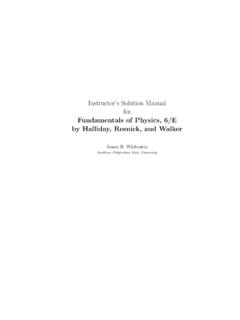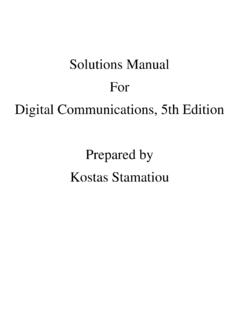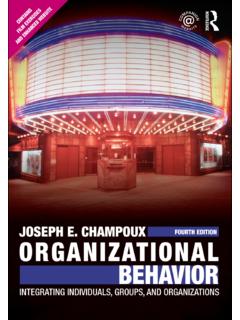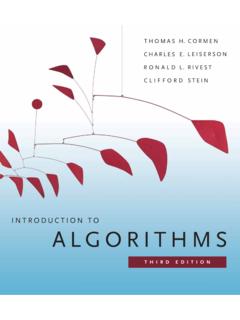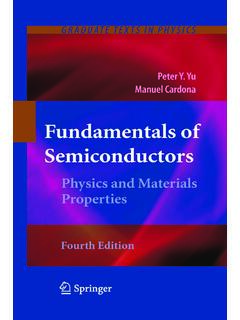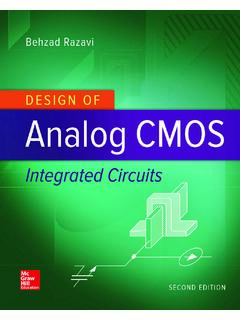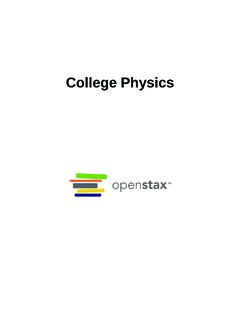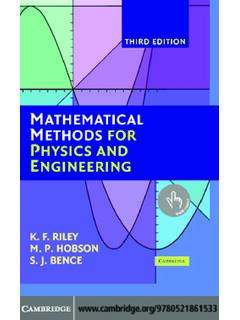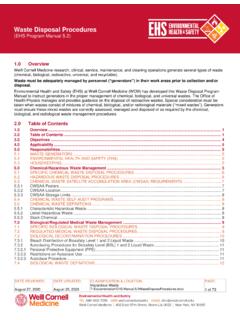Transcription of INSTRUCTOR SOLUTIONS MANUAL
1 INSTRUCTOR s MANUAL to accompany Modern physics , 3rd Edition Kenneth S. Krane Department of physics Oregon State university 2012 John Wiley & Sons iiPreface This INSTRUCTOR s MANUAL accompanies the 3rd edition of the textbook Modern physics (John Wiley & Sons, 2012). It includes (1) explanatory material for each chapter; (2) suggested outside readings for INSTRUCTOR or student; (3) references to web sites or other generally available simulations of phenomena; (4) exercises that can be used in various active-engagement classroom strategies; (5) sample exam questions; and (6) complete SOLUTIONS to the end-of-chapter problems in the text. Perhaps the greatest influence on my teaching in the time since the publication of the 2nd edition of this textbook (1996) has been the growth into maturity of the field of physics education research (PER).
2 Rather than indicating specific areas of misunderstanding, PER has demonstrated that student comprehension is enhanced by any of a number of interactive techniques that are designed to engage the students and make them active participants in the learning process. The demonstrated learning improvements are robust and replicable, and they transcend differences among instructors and institutional types. In my own trajectory in this process, I have been especially influenced by the work of Lillian McDermott and her group at the university of Washington1 and Eric Mazur at Harvard I am grateful to them not only for their contributions to PER but also for their friendship over the years. With the support of a Course, Curriculum, and Laboratory Improvement grant from the National Science Foundation3, I have developed and tested a set of exercises that can be used either in class as group activities or outside of class (for example, in a Peer Instruction mode following Mazur s format or in a Just-In-Time Teaching4 mode).
3 These exercises are included in this INSTRUCTOR s MANUAL . I am grateful for the support of the National Science Foundation in enabling this project to be carried out. Two Oregon State university graduate students assisted in the implementations of these reformed teaching methods: K. C. Walsh helped with producing several simulations and illustrative materials, with implementing an interactive web site, and with corresponding developments in the laboratory that accompanies our course, and Pornrat Wattanakasiwich undertook a PER project5 for her that involved the observation of student reasoning about probability, which lies at the heart of most topics in modern physics . One of the major themes that has emerged from PER in the past two decades is that students can often learn successful algorithms for solving problems while lacking a fundamental understanding of the underlying concepts.
4 The importance of the in-class or pre-class exercises is to force students to consider these concepts and to apply them to diverse situations that often cannot be analyzed with an equation. It is absolutely essential to devote class time to these exercises and to follow through with exam questions that require similar analysis and a similar articulation of the conceptual reasoning. I strongly believe that conceptual understanding is a necessary prerequisite to successful problem solving. In my own classes at Oregon State university I have repeatedly observed that improved conceptual understanding leads directly to improved problem-solving skills. In training students to reason conceptually, it is necessary to force them to verbalize their reasons for selecting a particular answer to a conceptual or qualitative question, and you will learn much from listening to or reading their arguments.
5 A simple iiimultiple-choice conceptual question, either as a class exercise or a test problem, gives you insufficient insight into the students reasoning patterns unless you also ask them to justify their choice. Even when I have teaching assistants grade the exams in my class, I always grade the conceptual questions myself, if only to gather insight into how students reason. To save time I generally grade such questions with either full credit (correct choice of answer and more-or-less correct reasoning) or no credit (wrong choice or correct choice with incorrect reasoning). Here s an example of why it is necessary to require students to provide conceptual arguments. After a unit on the Schr dinger equation, I gave the following conceptual test question: Consider a particle in the first excited state of a one-dimensional infinite potential energy well that extends from x = 0 to x = L.
6 At what locations is the particle most likely to be found? The students were required to state an answer and to give their reasoning. One student drew a nice sketch of the probability density in the first excited state, correctly showing maxima at x = L/4 and x = 3L/4, and stated that those locations were the most likely ones at which to find the particle. Had I not required the reasoning, the student would have received full credit, and I would have been satisfied with the student s understanding of the material. However, in stating the reasoning, the student demonstrated what turned out to be a surprisingly common incorrect mode of reasoning. The student apparently confused the graph of probability density with a similar sort of roller-coaster potential energy diagram from introductory physics and reasoned as follows: The particle is moving more slowly at the peaks of the distribution, so it spends more time at those locations and is thus more likely to be found there.
7 PER follow-up work indicated that the confusion was caused in part by combining probability distributions with energy level diagrams students were unsure of what the ordinate represented. As a result, I adopted a policy in class (and in this edition of the textbook) of never showing the wave functions or probability distributions on the same plot as the energy levels. The overwhelming majority of PER work has concerned the introductory course, but the effective pedagogic techniques revealed by that research carry over directly into the modern physics course. The collection of research directly linked to topics in modern physics is much smaller but no less revealing. The university of Washington group has produced several papers impacting modern physics , including the understanding of interference and diffraction of particles,, time and simultaneity in special relativity, and the photoelectric effect (see the papers listed on their web site, ref.)
8 1). The PER group of Edward F. Redish at the university of Maryland has also been involved in studying the learning of quantum concepts, including the student s prejudices from classical physics , probability, and (Further work on the learning of quantum concepts has been carried out by the research groups of two of Redish s students, Lei Bao at Ohio State University7 and Michael Wittmann at the university of ) Dean Zollman s group at Kansas State university has developed tutorials and visualizations to enhance the teaching of quantum concepts at many levels (from pre-college through advanced undergraduate).9 The physics education group at the university of Colorado, led by Noah Finkelstein and Carl Wieman, is actively pursuing several research areas involving modern physics and has produced numerous research papers as well as simulations on topics in modern Others who have conducted research on the teaching of quantum mechanics and developed interactive or evaluative materials include ivChandralekha Singh at the university of Pittsburgh11 and Richard Robinett at Pennsylvania State Classroom Materials for Active Engagement 1.
9 Reading Quizzes I started developing the interactive classroom materials for modern physics after successfully introducing Eric Mazur s Peer Instruction techniques into my calculus-based introductory course. Daily reading quizzes were a part of Mazur s original classroom strategy, but recently he has adopted a system that is more like Just-in-Time Teaching. Nevertheless, I have found the reading quizzes to work effectively in both my introductory and modern physics classes, and I have continued using them. We use electronic classroom communication devices ( clickers ) to collect the responses, but in a small class paper quizzes work just as well. Originally the quizzes were intended to get students to read the textbook before coming to class, and I have over the years collected evidence that the quizzes in fact accomplish that goal.
10 The quizzes are given just at the start of class, and I have found that they have two other salutary effects: (1) In the few minutes before the bell rings at the start of class, the students are not reading the campus newspaper or discussing last week s football game they are reading their physics books. (2) It takes no time at the start of class for me to focus the students attention or put them in the mood for physics ; the quiz gets them settled into class and thinking about physics . The multiple-choice quizzes must be very straightforward no complex thinking or reasoning should be required, and if a student has done the assigned reading the quiz should be automatic and should take no more than a minute or so to read and answer. Nearly all students get at least 80% of the quizzes correct, so ultimately they have little impact on the grade distribution.
